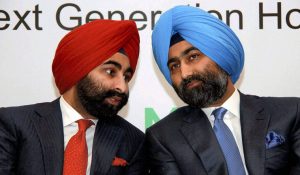All that you need to know about the fierce takeover battle of Fortis

KV Prasad Jun 13, 2022, 06:35 AM IST (Published)
 Listen to the Article (6 Minutes)
Listen to the Article (6 Minutes)
Summary
The board will meet on May 10 to decide on the advisory panel’s recommendations on the binding bids.
Fortis Healthcare has become a lodestar of a frenzied takeover battle, with five entities bidding for the cash-strapped hospital operator.
The Fortis board set up an expert advisory committee, comprising Deepak Kapoor and Lalit Bhasin, to evaluate the bids by these entities that are jostling to buy a significant stake or acquire the company. The board will meet on May 10 to decide on the advisory panel’s recommendations on the binding bids.
The deadline for submitting the final bids was May 1. The Manipal Hospitals-TPG consortium, one of the first bidders for the hospital, was exempted from the deadline and has until May 6 to match any new bids received until May 1.
Until May 1, the board received four binding bids from Manipal-TPG, businessmen Sunil Munjal and Anand Burman, IHH Healthcare of Malaysia and Radiant Life Care, backed by buyout company KKR. China’s Fosun International submitted a non-binding bid.
While the decision of the board will be depend on the best value and easiest structure, analysts are not ruling out it factoring in a key metric – experience of the bidder.
Here is what you need to know about Fortis and the bidders.
The Target: Fortis Healthcare
Gurugram-based Fortis Healthcare owns 34 hospitals and medical facilities across 10 states with a total of 4,445 beds. Fortis owns 29.8% stake in RHT Health Trust (RHT), the Singapore-listed entity that owns assets in 12 of the hospitals that Fortis operates. Fortis also owns 56.6% stake in SRL Diagnostics.
The combined revenue as of the third quarter of 2017-18 was Rs 3,727 crore with EBITDA margins of 6.4% and net debt of Rs 1,300 crore. Occupancy is at 72% and the average revenue per bed stands at Rs 1.4 crore.
Manipal-TPG: Early Mover
Manipal Hospitals, backed by private equity giant TPG, was one of the earliest bidders for Fortis. Manipal-TPG was forced to revise its binding bid after facing a storm of protests by shareholders. It is now proposing an open offer to public shareholders for buying 26% in the hospital business. The open offer price is Rs 121 per share.
In its revised offer, Manipal-TPG has raised the hospital valuation to Rs 6,322 crore against the previous Rs 6,061 crore. It also offered an immediate infusion of Rs 750 crore and also proposed to buy 5% stake in SRL from Fortis.
Manipal Hospitals, led by Rajan Pai, launched operations in the early 1990s. It is not listed and currently operates 11 hospitals with a total of 6,373 beds. Of these beds, Manipal owns a total of 2,973 beds and manages 3,400 beds. The group has added 1,100 beds in the past 18 months.
TPG owns 22% stake in Manipal whose majority of hospitals are in South India. Currently, Manipal has 45% occupancy, with 63% occupancy in older hospitals.
Revenue stands at Rs 1,500 crore, with margins at 15-16%, including the new hospitals.
TPG also has interests in other hospitals. It has invested Rs 220 crore in mother and child-care hospital chain Motherhood in 2016, and has a majority stake in Cancer Treatment Services International.
If Manipal-TPG acquires Fortis, the consortium will become a pan-India player with a strong presence in Bengaluru (1,600 beds) and the National Capital Region (1,900 beds).
The operational beds will rise to 6,567, with bed capacity rising to 7,658 with a total of 45 hospitals.
The Manipal-Fortis combine will become the No.2 hospital operator in India after Apollo Hospitals, which has 9,400 beds at 49 hospitals. The group’s consolidated revenue will jump to Rs 5,230 crore with margins of 14.2%. Through SRL Diagnostics, Manipal will enter diagnostics also.
Munjal-Burman: The Family Consortium
The consortium-led by Sunil Kant Munjal of Hero Enterprise and the Burman family of Dabur submitted a binding bid to invest Rs 1,800 crore in Fortis with Rs 1,050 crore upfront. It also offered to divest SRL through an independent valuation. They are planning to buy out RHT Holding using funds from SRL.
Munjal is the head of Dayanand Medical College and Hospital in Punjab with 1326 beds, off which 800 are teaching beds.
The Burman family was earlier the promoter of Dabur Pharma, a company focused on oncology products. The family exited the company in 2008 by selling its 65% stake to Germany’s Fresnius Kabi for Rs 775 crore.
The total deal size for 73% stake in Dabur Pharma was Rs 872 crore. The Burman family currently runs a venture named HealthCare at Home. It is a joint venture with the UK-based HealthCare at Home and is backed by private equity firm Quadria Capital.
HealthCare at Home provides healthcare services at home for patients. This includes elderly care, physiotherapy, nursing and ICU facilities, among other services. The venture is targeting revenue of Rs 1,000 crore by 2019-20. The company is also planning to hire 4,500 employees to its current workforce of 1,300-1,500 by the end of 2018-19.
The company is present in around 40 cities in India. The Burmans are also present in diagnostics with a venture named Onquest, which has over 33 labs with over 200 collection centres. Anand Burman is also the co-founder of Asian Healthcare Fund that has investments in dental chain company Sabka Dentist and primary healthcare clinic Healthspring.
IHH Healthcare: The Singapore Connection
Malaysia-based IHH Healthcare has offered a binding bid of Rs 650 crore at Rs 175 per share for Fortis. Its offer to infuse Rs 3,350 crore at up to Rs 175 per share is subject to due diligence.
Listed in Malaysia and Singapore, IHH is owned by Malaysian sovereign wealth fund Khazanah. It runs a total of 28 hospitals with more than 10,000 beds and is present in nine countries.
IHH, which recently began listing India as a target market along with Malaysia, Singapore and Turkey, has six hospitals and three medical centres in India. In 2015, the company entered the Indian market on a standalone basis after acquiring 73.4% stake in Global Hospitals and majority stake in Continental Hospital.
Prior to that, IHH held 10.8% stake in Apollo Hospitals, but sold it in 2017 for nearly 2,000 crore. The sale translated to a 2.5x gain from its initial investment in 2011.
The company has now consolidated its operations under the Gleneages brand in India. As of 2017, the company has 1,192 operational beds in India, with occupancy rates of 63% up from 56% the previous year.
In 2017, IHH’s acquisitions in India turned EBITDA positive. The company’s latest quarterly numbers show that India operations grew 3.9%, with inpatient admissions growing 15.4%.
If IHH manages to add Fortis to its kitty, the total hospital and medical centre count will increase to 43 facilities, with over 5,500 operational beds. IHH, however, has run into a few hassles in India, especially the opposition by the owners of Continental Hospital to a rights issue that it proposed.
Radiant-KKR: The Other PE-Backed Bidder
Mumbai-based Radiant Life Care, backed by buyout firm KKR, entered the fray as the fifth bidder. It proposed a binding bid to buy Fortis’s Mulund Hospital at a value of Rs 1,200 crore.
Radiant is promoted by Abhay Soi.
The company is looking to refurbish its hospitals business. It undertook redevelopment of the 650-bed BLK Super Speciality Hospital in New Delhi in 2010 and the 350-bed Nanavati Hospital in Mumbai in 2014.
The bed capacity of both the hospitals has since expanded – 1,600 capacity for BLK and 1,000 hospital for Nanavati.
In 2017, private equity firm KKR bought a 49% stake in the company by investing 1,288 crore. KKR has also invested Rs 550 crore in Apollo Hospitals’ holding firm and provided debt funding of Rs 560 crore to promoters of diagnostic company Metropolis.
Fosun International: The Chinese Bidder
Of the five companies, China-based Fosun International is the only company that offered a non-binding bid.
The company offered, $350 million, or Rs 23,38 crore, for 25% of Fortis with an immediate infusion of Rs 100 crore.
Founded in 1992 in Shanghai, Fosun International was listed on the Main Board of the Hong Kong Stock Exchange in 2007. It has interests across industries ranging from pharma, health to fashion and financial services.
Fosun has stakes in over 10 healthcare related firms worldwide.In India, Fosun has picked up 74% stake in Indian pharma company Gland Pharma for $1.1 billion. Fosun does not have any presence in Indian healthcare providers.

Elon Musk forms several ‘X Holdings’ companies to fund potential Twitter buyout
3 Mins Read
Thursday’s filing dispelled some doubts, though Musk still has work to do. He and his advisers will spend the coming days vetting potential investors for the equity portion of his offer, according to people familiar with the matter

KV Prasad Journo follow politics, process in Parliament and US Congress. Former Congressional APSA-Fulbright Fellow











 Listen to the Article
Listen to the Article 
 Daily Newsletter
Daily Newsletter

























